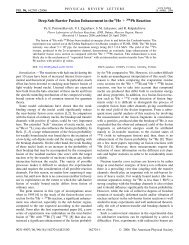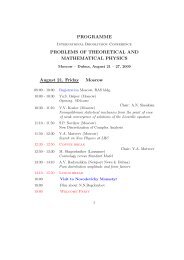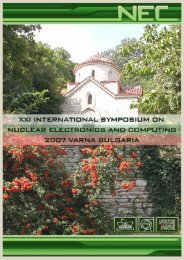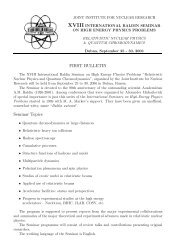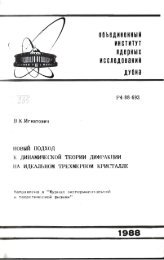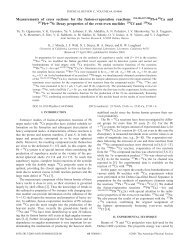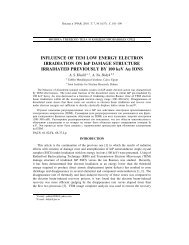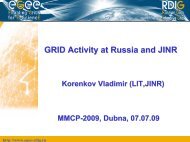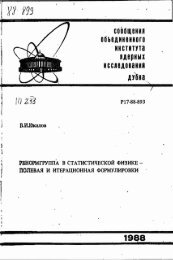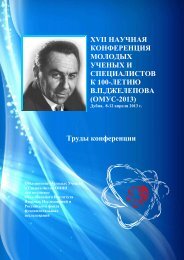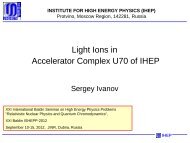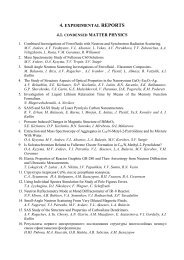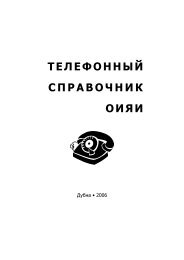Joint Institute for Nuclear Research Relativistic ... - Index of - JINR
Joint Institute for Nuclear Research Relativistic ... - Index of - JINR
Joint Institute for Nuclear Research Relativistic ... - Index of - JINR
You also want an ePaper? Increase the reach of your titles
YUMPU automatically turns print PDFs into web optimized ePapers that Google loves.
QUARK AND HADRON DEGREES OF FREEDOM IN THE ROPER<br />
RESONANCE ELECTROPRODUCTION<br />
I.T. Obukhovsky †<br />
Instutute <strong>of</strong> <strong>Nuclear</strong> Physics, Moscow State University, 119991, Moscow, Russia<br />
† E-mail: obukh@nucl-th.sinp.msu.ru<br />
We suggested [1] a two-component model <strong>of</strong> the lightest nucleon resonance<br />
R = N 1/2 +(1440) as a combined state <strong>of</strong> the quark configuration sp 2 [3] X and the hadron<br />
molecule component N + σ. This approach allows to describe with reasonable accuracy<br />
the recent CLAS electroproduction data [2] at low- and moderate values <strong>of</strong> Q 2 with<br />
0≤ Q 2 1.5 – 2 GeV 2 . In the model the R → N + (ππ) I=0<br />
Swave transition process is<br />
interpreted as the decay <strong>of</strong> a virtual σ meson in the N + σ component. The calculated<br />
decay width Γ R→Nσ(ππ) correlates well with the PDG value and the recent CB-ELSA and<br />
A2-TAPS data [3]. The weight ≈ 0.36 <strong>of</strong> the N+σ component in the Roper is compatible<br />
with the CLAS data at low and moderate Q 2 . This weight is also compatible with the<br />
value <strong>of</strong> the helicity amplitude A 1/2 at the real photon point.<br />
However, our evaluations have shown that at low Q 2 the contribution <strong>of</strong> the pion cloud<br />
to the amplitude A 1/2 can be considerable (see e.g. [4]). For example, this is evident from<br />
comparison <strong>of</strong> our results with the data in low-Q 2 region. The discrepancy <strong>of</strong> our results<br />
and the CLAS data is about 1 – 1.5 experimental error bars. Still, this discrepancy<br />
is considerably smaller than in the case <strong>of</strong> previous quark models: the valence quark<br />
covariant spectator model [5]) or the LF models [4] in the same region <strong>of</strong> Q 2 1 GeV 2 /c 2 .<br />
In this work we tried to show that the description <strong>of</strong> transition amplitudes in terms <strong>of</strong><br />
parton-like models, which are very good at high Q 2 , can be naturally trans<strong>for</strong>med into a<br />
description in terms <strong>of</strong> the ‘s<strong>of</strong>t‘ vector meson cloud at low Q 2 . This smooth transition is<br />
achieved by ’switching on’ a non-zero radius <strong>of</strong> the intermediate vector meson. The vector<br />
meson V <strong>of</strong> finite size generates a non-local Vqq interaction when it is considered in terms<br />
<strong>of</strong> the 3 P 0 model. This weakens the effect <strong>of</strong> the orthogonality <strong>of</strong> the spatial R and N<br />
wave functions in the low-Q 2 transition matrix element N +γT ∗ → R (the amplitude A 1/2<br />
near the real photon point). A relativistic generalization <strong>of</strong> our model is in progress.<br />
References<br />
[1] I.T. Obukhovsky, A. Faessler, D.K. Fedorov, Th. Gutsche, and V.E. Lyubovitskij,<br />
Phys. Rev. D84, 014004 (2011).<br />
[2] I. G. Aznauryan et al. (CLAS Collaboration), Phys. Rev. C 80, 055203 (2009).<br />
[3] A. V. Sarantsev et al. (CB-ELSA and A2-TAPS), Phys. Lett. B 659, 94 (2008).<br />
[4] I.G. Aznauryan and V.D. Burkert, Phys. Rev. C85, 055202 (2012).<br />
[5] G. Ramalho and K. Tsushima, Phys. Rev. D 81, 074020 (2010).<br />
101



